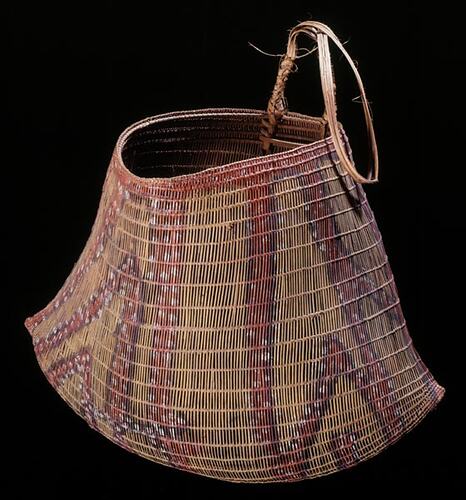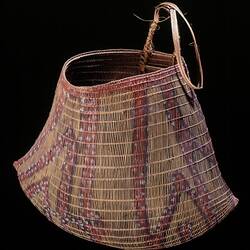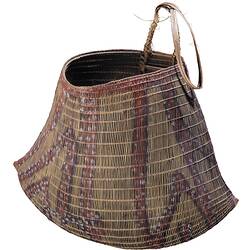Summary
This is a typical example of the distinctive two-cornered or bicornual basket made in the rainforest area of north Queensland from fine strands of lawyer cane (Calamus caryotoides). Historically bicornual baskets were crafted by both men and women and the distinctive shape achieved using a twining technique. The vine was collected from the rainforest and cut into lengths, heated over a fire to make them pliable and then split and scraped to form fine strands necessary to form the body of the basket. A different lawyer cane, Calamus australis, was used for the handle.
These baskets were either left unpainted or the entire surface coated in red ochre, which was manufactured locally by heating yellow ochre. Depending on the detail required, pigments were applied with a stick frayed at the ends to form a brush or those made from hair or with the fingers. Pigments were ground into a powder with a pestle-type stone and mixed with a binding fluid. These distinctive bicornual baskets are only made by Aboriginal people of four different language groups who live in the rainforest region of north Queensland between Ingham and Cooktown, and are known as 'janjuu' by speakers of the Ngadjon language and 'jawun' by the Jirrbal. Men and women used them to carry bush foods and personal belongings, but the two-cornered shape of the base made it ideal to use as a trap or a sieve for preparing poisonous cycad nuts. The basket would be secured in a stream of running water that would leaching out the toxins from the nuts, after which they were pounded using hammerstones and anvils and made into cakes that were cooked and eaten.
This basket style was made particularly in the Cardwell area and traded as part of a network amongst rainforest groups as far north as Port Douglas. Cardwell was the first settlement in the region being established in 1863 and quickly attracted settlers and prospectors as well as scientists and collectors. By the 1870s a thriving market for Aboriginal artefacts existed at Cardwell and the other settlements of Atherton, Babinda, Herberton, Herbert River, Kuranda, Mareeba, Mossman, Russell River and Tully River. Many of these places had depots for regularly distributing government rations and blankets and such events would attract collectors seeking artefacts and photographers who would document performances staged for this purpose. While Aboriginal people's need for these artefacts had diminished or almost disappeared, enterprising individuals realised that artefacts were a highly sought commodity. Large numbers of bicornual baskets found in museums today originate from this time, however they had all but disappeared by end of the nineteenth century.
Physical Description
A two-cornered or bicornual shaped basket made of lawyer cane decorated with natural pigments. The abstract designs are painted with red, black and white. The remnants of a cane fibre handle are attached to the rim at the back.
More Information
-
Object/Medium
Basket
-
Maker
-
Locality
-
Date Produced
-
Collector
-
Date Collected
-
Object Measurements
610 mm (Length), 580 mm (Width), 390 mm (Height)
-
Keywords
-
References
[Catalogue] Rowlison, Eric, et al. 1981. Aboriginal Australia.
[Book] Museum Victoria. 2004. Treasures of the Museum. Victoria, Australia. 206.
-
Collection Names
-
Type of item
-
Discipline
-
Category
-
Collecting Areas
Australian Indigenous - Northern Australia and Queensland and Torres Strait Islands


